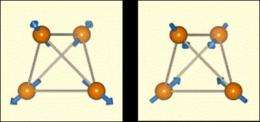Spin structure reveals key to new forms of digital storage, study shows

A synthetic compound long known to exhibit interesting transition properties may hold the key to new, non-magnetic forms of information storage, say researchers at the RIKEN SPring-8 Center and their collaborators. The team's latest findings shed light on the complex relationship between a compound's electron spin arrangement and its transport properties, an area researchers have long struggled to understand.
The metal-insulator transition (MIT) is a phenomenon in which certain (electricity-conducting) metals make a sudden transition to become a (non-conducting) insulator when cooled below a given temperature. Unlike pure insulators such as silicon and germanium, and pure conductors such as gold and silver, metals with MITs are by their nature unstable and difficult to characterize. This instability is also their strength: complex materials with MITs such as semiconductors form the building blocks for much of our modern technology.
Elucidating the physical basis for MIT, one of the oldest and least well-understood phenomena in condensed matter physics, would shed light on the electron transport properties of a wide range of potentially useful materials. Among these materials, the compound Cd2Os2O7, first discovered more than 30 years ago, has recently attracted renewed attention. Cd2Os2O7 has the intriguing property that when cooled to 227K (-46 °C), it undergoes both a metal-insulator transition and a magnetic transition to a state in which all its electron spins are aligned. This spin alignment, which makes the material magnetic, is useful for a wide array of applications, notably information storage.
Previous efforts to elucidate this magnetic structure, however, have been complicated by another property of Cd2Os2O7: its propensity to absorb neutrons, which interferes with standard neutron scattering techniques used to analyze magnetism. To get around this problem, the researchers employed an alternative technique known as resonant x-ray scattering (RXS) using synchrotron radiation from the RIKEN SPring-8 facility, the world's most powerful synchrotron light source. Their results show that at 227K, Cd2Os2O7 structures itself into a tetrahedral network of osmium atoms with electron spins in each tetrahedron pointing in one of two directions: all inward, or all outward (Figure 1). The structure of this unusual "all-in-all-out" arrangement is such that the spins cancel each other out, so that the material as a whole is not magnetic.
Cd2Os2O7 thus has all the makings of a new kind of information storage medium, one whose binary bits of information ("all-in" and "all-out" spin arrangements) would, unlike present-day computer memory, be largely unaffected by surrounding magnetic fields. The results also provide fundamental insights into how electron spin can influence a material's transport properties, with broad applications in condensed matter physics.
Provided by RIKEN


















